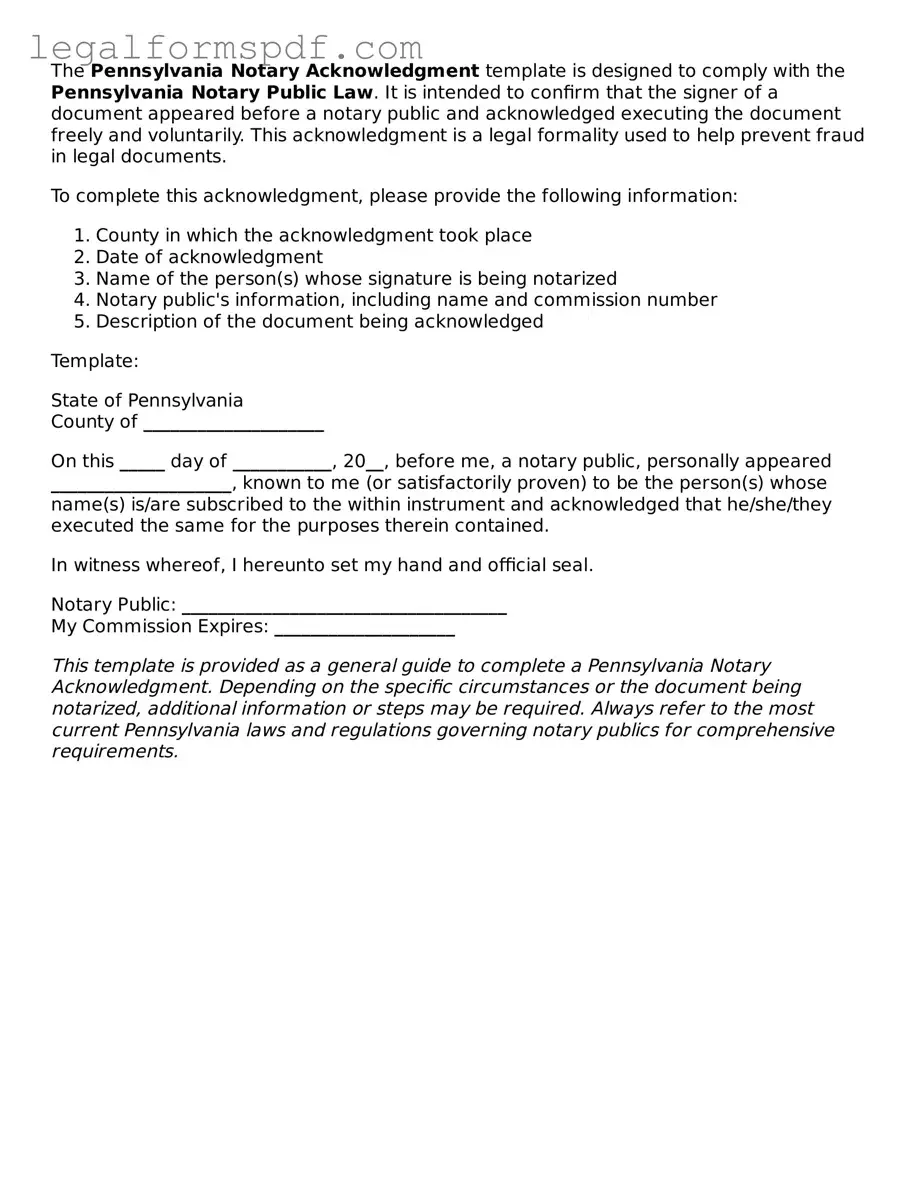What is a Pennsylvania Notary Acknowledgement form?
A Pennsylvania Notary Acknowledgement form is a legal document used to verify the signature of a person on a document. It is an official declaration by a notary public that the signer has appeared before them, proven their identity, and acknowledged they signed the document willingly and under their own power. This form provides an extra level of assurance that the document is authentic and can be crucial for legal processes where verifying the identity of the signer is necessary.
Who can notarize a document in Pennsylvania?
In Pennsylvania, a notary public is an individual commissioned by the Department of State who has the authority to notarize documents. Notaries must go through a certification process, which includes passing an exam and undergoing a background check. Attorneys licensed in Pennsylvania and certain other court-appointed officials can also perform notarial acts.
What identification is needed for notarization in Pennsylvania?
When appearing before a notary public in Pennsylvania, individuals must provide satisfactory evidence of identity. This typically means presenting a government-issued photo ID, such as a driver's license, passport, or state identification card. The ID must be current or issued within the last five years to be considered valid.
Can a document be notarized without the signer being present?
No, the Pennsylvania notary law requires the signer to be physically present before the notary public at the time of the notarization. This ensures that the notary can verify the signer's identity and willingness to sign the document. Remote notarization is not considered the same as being physically present.
How long is a Notary Acknowledgement valid in Pennsylvania?
The acknowledgement itself does not expire; however, the document's legal validity depends on its content and purpose. The notary public's seal and signature indicate that the acknowledgement occurred on a specific date, but the ongoing validity of the document is subject to Pennsylvania law and the context in which it is used.
Can any document be notarized in Pennsylvania?
Most documents can be notarized in Pennsylvania, as long as they meet state requirements and the signer is present with valid identification. However, a notary cannot notarize documents they have a personal interest in or documents that contain incomplete information.
Is a notarized document legally binding in Pennsylvania?
Notarization itself does not make a document legally binding. It simply verifies the signer's identity and that they signed the document voluntarily. The document's legal binding status depends on its content, the context in which it is used, and adherence to Pennsylvania law.
What happens if a notary public makes a mistake?
If a notary public in Pennsylvania makes a mistake during the notarization process, it can potentially invalidate the notarization or lead to legal complications. Mistakes should be corrected immediately upon discovery, and serious errors may need to be reported to the Department of State. In some cases, the document may need to be resigned and notarized again.
Can a Pennsylvania notary notarize for family members?
While Pennsylvania law does not expressly forbid notaries from notarizing documents for family members, it is highly discouraged. Notarizing for a family member can raise questions about impartiality and conflict of interest, potentially invalidating the notarization if the impartiality of the notary is called into question.
How can someone become a notary public in Pennsylvania?
To become a notary public in Pennsylvania, an individual must complete an application, pass a state-administered exam, and undergo a background check. Candidates must also complete a mandatory training course unless they are an attorney or have previously been a notary. Once commissioned, notaries must obtain a notary stamp and keep a record book of all notarizations performed.
